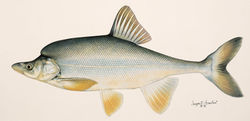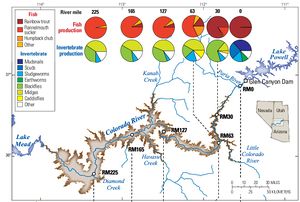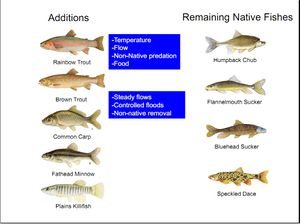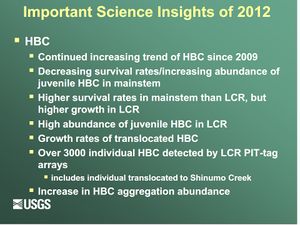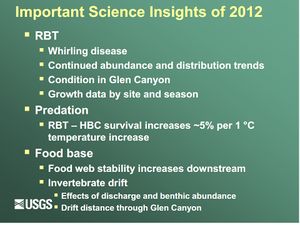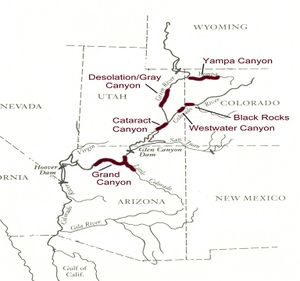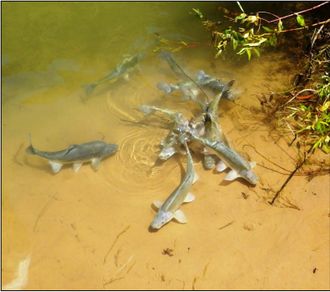- Fact Sheets
- Training
- Knowledge Assessments
- Trivia
- Key Topics
Difference between revisions of "FISH"
(fish) |
Cellsworth (Talk | contribs) |
||
| Line 58: | Line 58: | ||
**Caught October 9th, lower part of Grand Canyon believed to have traveled upstream some 50 miles from Lake Mead. | **Caught October 9th, lower part of Grand Canyon believed to have traveled upstream some 50 miles from Lake Mead. | ||
*'''[http://gcdamp.com/index.php?title=Whirling_Disease Whirling Disease Page]''' | *'''[http://gcdamp.com/index.php?title=Whirling_Disease Whirling Disease Page]''' | ||
| − | |||
---- | ---- | ||
| − | |||
| − | |||
| − | |||
===''Quick Facts''=== | ===''Quick Facts''=== | ||
*Diet studies of Rainbow Trout and Brown Trout in Grand Canyon indicate that these species do eat native fish. | *Diet studies of Rainbow Trout and Brown Trout in Grand Canyon indicate that these species do eat native fish. | ||
| Line 76: | Line 72: | ||
*[[Image:Little Colorado River PIT-tag arrays.jpg|thumb|left|250px]] | *[[Image:Little Colorado River PIT-tag arrays.jpg|thumb|left|250px]] | ||
*[[Media:RValdez Talus shoreline habitat used by HBC.doc| RValdez_Talus shoreline habitat used by HBC]] | *[[Media:RValdez Talus shoreline habitat used by HBC.doc| RValdez_Talus shoreline habitat used by HBC]] | ||
| + | |||
**'''[[GCDAMP Fish| Fish]]''' | **'''[[GCDAMP Fish| Fish]]''' | ||
| − | |||
| − | |||
*[http://www.ehow.com/facts_5498153_kind-fish-lake-powell.html What type of fish are found in Lake Powell?] | *[http://www.ehow.com/facts_5498153_kind-fish-lake-powell.html What type of fish are found in Lake Powell?] | ||
*1.Endangered | *1.Endangered | ||
| − | + | ◦Four types of fish that frequent the Colorado River and Lake Powell are officially endangered because of the construction of dams and introduction of non-native species: the razorback sucker, Colorado pikeminnow, humpback chub and bonytail. | |
| − | + | ||
Native | Native | ||
| − | + | ◦In addition to the above, Lake Powell is naturally home to the bluehead sucker, flannelmouth sucker, roundtail chub and speckled dace. | |
| − | + | ◦Non-Native Bass | |
| − | + | ◦The National Park Service introduced three types of bass specifically for fishing purposes: the smallmouth bass, largemouth bass and striped bass. | |
| − | + | ||
| − | + | ||
| − | + | ||
Other Non-Natives For Fishing | Other Non-Natives For Fishing | ||
| − | + | ◦Other non-native species have been introduced into Lake Powell with the intent of challenging fisherman. These include walleye, rainbow trout, channel catfish, bluegill and black crappie. | |
| − | + | ||
Problematic Non-Native | Problematic Non-Native | ||
| − | + | ◦Though almost all non-natives are damaging to native ecosystems, the gizzard shad is causing many problems to the native and non-native fish populations because of its large size. The fish has spread throughout the lake and have no natural predators. | |
| − | + | ||
|} | |} | ||
| Line 108: | Line 97: | ||
*"Prior to Glen Canyon Dam, the Colorado River was dominated by highly predacious non-native channel catfish. Catfish are warm water fish...Regular flooding of the LCR may be keeping catfish out of the LCR and cold water in the Colrado River does not provide habitat for catfish or other warm water fish. Without Glen Canyon Dam chubs may have been extirpated from Grand Canyon, catfish would still be the dominant fish in the Colorado River and the LCR." ''(090711_Minority Report to TWG_FFF_Mark Steffen)'' | *"Prior to Glen Canyon Dam, the Colorado River was dominated by highly predacious non-native channel catfish. Catfish are warm water fish...Regular flooding of the LCR may be keeping catfish out of the LCR and cold water in the Colrado River does not provide habitat for catfish or other warm water fish. Without Glen Canyon Dam chubs may have been extirpated from Grand Canyon, catfish would still be the dominant fish in the Colorado River and the LCR." ''(090711_Minority Report to TWG_FFF_Mark Steffen)'' | ||
*[http://www.scientificamerican.com/article.cfm?id=grand-canyon-fish-relocation-spurs-recovery Should a disaster such as a landslide cut off the Little Colorado chub from the mainstem, the species could quickly become extinct -Article LINK] | *[http://www.scientificamerican.com/article.cfm?id=grand-canyon-fish-relocation-spurs-recovery Should a disaster such as a landslide cut off the Little Colorado chub from the mainstem, the species could quickly become extinct -Article LINK] | ||
| − | |||
| − | |||
| − | |||
| − | |||
| − | |||
| − | |||
| − | |||
<!-- | <!-- | ||
| Line 124: | Line 106: | ||
|- | |- | ||
|style="color:#000;"| | |style="color:#000;"| | ||
| − | * | + | *[http://gcdamp.com/index.php?title=Humpback_Chub_Page| Humpback Chub Page] |
| + | *[[GCDAMP RAZU Fish| Razerback Sucker Page]] | ||
| + | *[[GCDAMP Bonytail Fish| Bonytail Page]] | ||
| + | *[http://gcdamp.com/index.php?title=FISHERY| Trout Fishery Page] | ||
*[http://www.gcdamp.gov/keyresc/nf.html GCDAMP POAHG- Historical Native Fishes of Glen and Grand Canyon] | *[http://www.gcdamp.gov/keyresc/nf.html GCDAMP POAHG- Historical Native Fishes of Glen and Grand Canyon] | ||
| − | |||
| − | |||
| − | |||
| − | |||
| − | |||
* | * | ||
| Line 137: | Line 117: | ||
|- | |- | ||
|style="color:#000;"| | |style="color:#000;"| | ||
| − | *[http://www. | + | 2015 |
| − | + | *[http://www.usbr.gov/uc/rm/amp/twg/mtgs/15jan20/Attach_10.pdf/ Native and Nonnative Interactions; Factors Influencing Predation and Competition] | |
| − | + | ||
| − | + | ||
| − | + | ||
|- | |- | ||
| Line 166: | Line 143: | ||
*[[File:HBC-Kurt- PIC.jpg|330px]] | *[[File:HBC-Kurt- PIC.jpg|330px]] | ||
| − | <Span> | + | <Span></Span> |
Revision as of 17:29, 6 January 2016
|
Description The Colorado River running through Grand Canyon once hosted one of the most distinctive fish assemblages in North America. The wild Colorado River presented fish with a challenging and variable aquatic habitat: very large spring floods, near-freezing winter temperatures, warm summer temperatures, and a heavy silt load. Note that only eight fish species were native to Grand Canyon. Of the eight species, six are endemic, meaning that they are only found in the Colorado River basin. (NPS)
|
| Fish Species of the Colorado River in Lower Glen Canyon and Grand Canyon (See Fish Table) |
TBD (TBD) |
TBD (TBD) |
|---|
|
|
